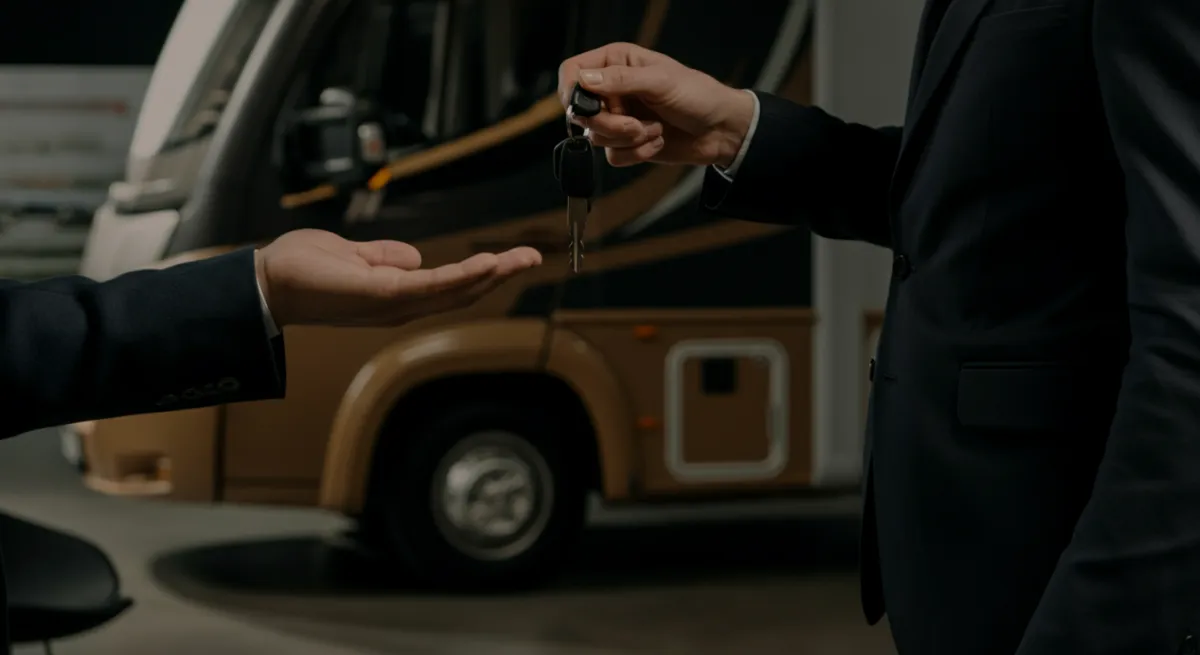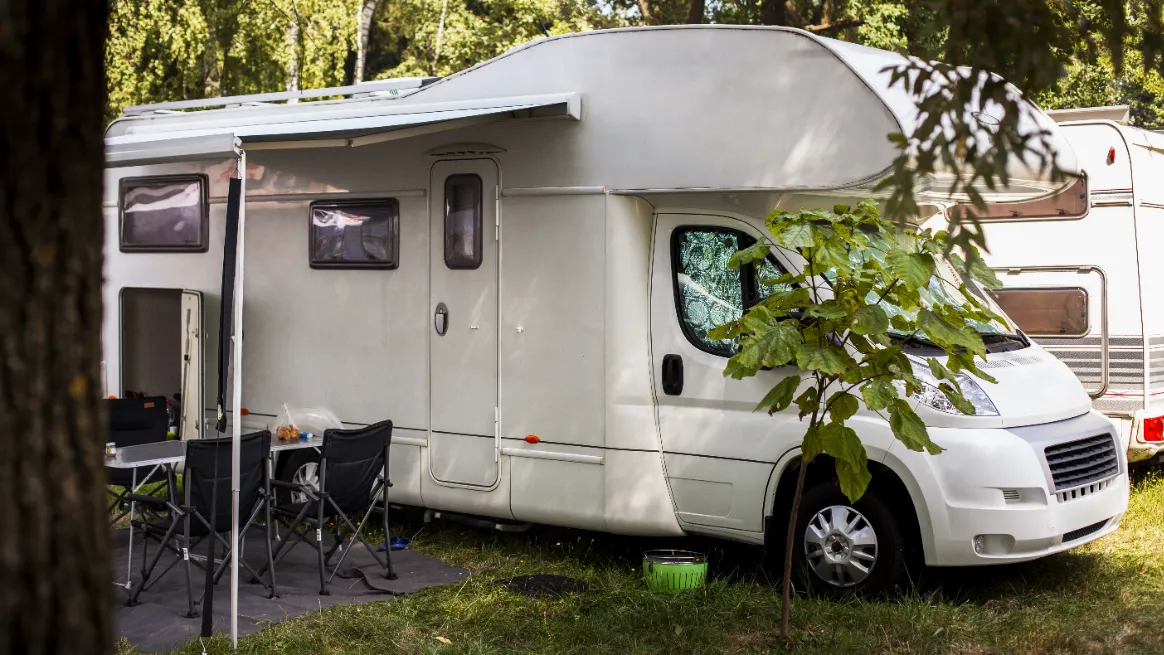You’ve got an RV, an idea, and maybe even a little ambition. Now you’re wondering how to start an RV rental business that actually runs itself. Fair question, and you’re not alone.
We get it. You want a flexible, profitable business. The RV rental market is predicted to hit $1.55 billion by 2030, and those who start early are reaping the rewards.
We’ll cover everything from startup costs to automation tools that make management easy. Ready to turn those wheels into income?
Let’s get this show on the road.
Is RV Rental a Good & Profitable Business?

Running an RV rental business can be a profitable venture if you manage it smartly.
Since the pandemic, more people want to travel in flexible and self-contained ways. From families to digital nomads, RVs are a popular choice for exploring.
The global RV rental market was worth $820.4 million in 2021 and is expected to reach $1.55 billion by 2030, growing at 7.4% per year. A great opportunity for new investors!
You can buy an RV and rent it out yourself or use platforms like Outdoorsy or RVshare. Owning gives you more control, while platforms make it easier and less risky to get started.
Occupancy rates can vary widely by RV type, season, and location, but many operators use the 40–50% range as a rough benchmark.
With smart pricing, regular maintenance, and smart management, you can increase your return on investment and build a steady income year-round.
RV Rental Income & Profit Overview
RV Type | Avg Daily Rate | Avg Occupancy | Est. Monthly Profit |
Class A Motorhome | $275–$300 | 45% | $3,700 |
Class B Campervan | $220–$238 | 50% | $3,300 |
Class C Motorhome | $215 | 45% | $3,000 |
Travel Trailer | $115–$120 | 40% | $1,500 |
Pop-Up Camper | $90–$100 | 45% | $1,200 |
Disclaimer: These figures are illustrative examples based on assumed rates and occupancy levels. Actual results can vary significantly depending on your market, maintenance costs, downtime, and demand.
How Much Can You Make with an RV Rental Business?

How much you can make renting out your RV depends on your RV type, location, and how often it’s booked (occupancy rate). With a smart strategy, even a single RV can generate a steady income.
Many owners aim to rent their RVs for around 100–200 days per year, depending on local demand and seasonal trends.
Bookings are highest during peak seasons like summer, while winter may require offering discounts. RVs near popular spots like national parks or beaches also earn more.
Let’s look at an example. Renting a Class C motorhome for 15 days a month at $150 per day could bring in $2,250. After subtracting costs like insurance and maintenance, you might keep around $1,200–$1,500.
By expanding your RV fleet and managing it efficiently with tools like RentMy, you’ll see how the right strategies can make any rental business more profitable.
Average RV Rental Rates and Annual Earning Potential
RV Type | Daily Rate | Weekly Rate | Annual Earning Potential (150 Rental Days) |
Class A Motorhome | $300 | $2,100 | $45,000 |
Class B Campervan | $238 | $1,666 | $35,700 |
Class C Motorhome | $215 | $1,505 | $32,250 |
Travel Trailer | $116 | $812 | $17,400 |
Pop-Up Camper | $91 | $637 | $13,650 |
Note: These earning figures are estimates based on 150 booked days at standard rates. Actual income varies with location, demand, and maintenance. Always factor in expenses like insurance, depreciation, storage, and repairs to determine your true net profit.
How to Start an RV Rental Business in 8 Steps
Starting an RV rental business takes more than just buying an RV. You need a plan, the right setup, and systems to protect your investment. Whether you’re starting small or building a fleet, these seven steps will help you launch your rental business.
Step 1: Research the Market & Identify Profit Opportunities

Understanding your market helps you decide on pricing, location, and the right type of RV to buy. Without research, you might end up with no bookings and wasted money.
A. Analyze Local Demand
Find out who’s renting RVs near you (More on this later) and when. Local demand changes throughout the year; families rent during school breaks, while couples and remote workers prefer quieter seasons.
If you’re near a popular spot like a national park or beach, expect more bookings on holidays and weekends. Areas with mild weather might get renters year-round.
Look at rental platforms, Google Trends, travel blogs, social media and regional tourism data to learn what people want.
Do they prefer small campervans or luxury motorhomes? Short weekend trips or long adventures? These small details reveal what to stock, how to price, and when to run promotions.
The goal is simple: match your offerings with local travel behavior so your RVs stay booked more often.
B. Study Competitors
Once you know what customers want, look at your competitors. This business analysis helps you spot who’s doing well in local rentals and why.
Start by checking RV rental companies near you or listings on popular sites.
Look at their pricing, photos, and renter reviews. See what guests love, like quick pickup times or spotless interiors. Also, notice where competitors fail, such as poor communication or limited add-ons. These weak spots can become your advantages.
See how they advertise online. Do they use local SEO, paid ads, or social media? Knowing this helps you draft your marketing plan. You can attract the same people without copying others directly.
If you combine what you learn about competitors with your demand research, you’ll find profitable ways to make money that others missed.
Small differences, like offering RVs for pets or special weekend deals, can quickly set your business apart.
C. Calculate Potential ROI
After analyzing your market and competitors, it’s time to calculate your potential return on investment (ROI). This will show if your RV rental business can be profitable.
First, estimate your gross income. For example, if you rent your RV for 15 days a month at $200 per day, you’ll earn 15 × $200 = $3,000/month.
Next, list your monthly expenses. This could include maintenance ($300), insurance ($150), cleaning ($100), platform fees ($450), fuel ($100), repairs ($200), and taxes ($300), totaling $1,600.
Now, subtract your expenses from your gross income to find your net profit: $3,000 – $1,600 = $1,400 per month. Multiply that by 12, and you’re earning $16,800/year.
If your total investment was $60,000, your ROI is:
($16,800 ÷ $60,000) × 100 = 28%.
That’s a solid return for a business you can scale by adding more RVs or renting more often. Keep in mind that these numbers depend on your location, demand, and maintenance costs. However, this simple calculation gives you a good idea of what you could earn.
Step 2: Choose Your Business Model

Before you start, you need to know how the RV rental business works. It’s like picking your strategy; each one changes how you operate, grow, and earn. There are four main ways to do this business, each fit for different budgets and goals.
1. Owner-Operator Model
The Owner-Operator model means you buy RVs and do everything yourself. This includes rentals, cleaning, maintenance, and taking care of guests. It takes a lot of work, but you keep all the profits. It’s great if you like being in control and working directly with renters.
Key Business Traits:
- Low startup cost
- Moderate risk
- Moderate scalability
2. Fleet Model
The Fleet model means you have many RVs and staff to manage logistics. It requires a high investment to start, but it can also make a lot of profit. This model is ideal for entrepreneurs looking to build a full-scale business, not a side hustle.
Key Business Traits:
- Higher startup investment
- High scalability and profit potential
- Greater operational risk
3. Consignment Model
The Consignment model lets you manage and rent out RVs owned by others. This lowers startup costs while still earning you commissions on bookings. It’s a smart way to grow without big upfront expenses.
Key Business Traits:
- Low capital requirement
- Shared risk
- Scalability depends on partnerships
4. Peer-to-Peer (P2P) Model
Finally, the Peer-to-Peer model works through platforms like Outdoorsy and RVshare. You list your RV, and they take care of exposure, payments, and insurance. It’s an easy, low-risk option for beginners.
Key Business Traits:
- Low startup cost
- Lower risk
- Variable profits depending on listing performance
RV Rental Business Models Overview
Model | Startup Cost | Risk | Profit Potential | Scalability |
Owner-Operator | Low to Medium | Moderate | Moderate | Moderate |
Fleet | High to Very High | High | High to Very High | High |
Consignment | Low | Low to Moderate | Medium | Medium (Partnership Dependent) |
Peer-to-Peer (P2P) | Very Low | Low | Variable (Low to Medium) | High |
Every model has pros and cons in terms of cost, risk, and how much it can grow. Pick one that fits your goals, resources, and how involved you want to be.
Step 3: Create Your RV Rental Business Plan

You’ll need a clear plan before you can list your first RV or build your website. This foundation will keep your business on track as it grows and help you avoid expensive mistakes later on.
Your RV rental business plan is like a GPS tracker; it shows your destination and how to get there. Without it, you risk unexpected detours.
Start simple: outline your goals. Who do you want to serve? What trips might your renters take? Which RVs suit their lifestyles? Clear goals guide your spending.
Set your prices by looking at local demand. Research competitors, travel seasons, and typical trip lengths to create realistic pricing.
Plan your marketing plan next. Focus on local search, social media, and where your renters spend time online. Even a basic plan keeps you consistent.
Finally, list your expenses like cleaning, insurance, and maintenance, and compare them to your expected income. Seeing your finances clearly makes decisions easier.
Once you’ve got the basics covered, it’s time to get your RV rental business legally registered.
Step 4: Get Legal, Insured & Financially Protected

Okay, you’ve got your business foundation and know your market. Now, protect it! Without the right safety measures, one accident, lawsuit, or tax error could deeply hurt your rental business profits. Let’s look at two key parts: insurance and tax strategy.
A. Register & Structure Your Business
Once you’ve chosen your model, make your business official. You can register as an LLC or sole proprietorship for legal protection and to keep finances clear. This helps with bank accounts and insurance.
After registration, apply for an EIN. This number organizes your taxes and separates personal from business earnings, making financial steps smoother.
Next, plan your budget with strong financial management strategies. This helps track spending, prepare for slow periods, and avoid surprises. Understanding your cash flow is the way.
Finally, handle taxes. RV rental taxes vary by state, so register for the right sales tax where you operate. Compliance prevents penalties. A tax professional can offer valuable advice.
B. Secure the Right Insurance Coverage for Your RV Rental Business
Securing the right insurance for your rental business is a must for long-term success. It protects you from property damage, guest liabilities, and lost income.
A strong policy should include liability coverage for injuries or damage during a rental, collision coverage for accident repairs, and comprehensive protection against theft, fire, or natural disasters.
Some insurers also offer coverage if you rent out your RV. This gives customers more protection.
But remember, many personal RV policies don’t cover renting or commercial use. You’ll need a special policy for that.
RV rental insurance costs depend on the type of vehicle, location, and use.
Basic coverage can cost $1,000–$1,500 per year, but rental-specific or commercial policies are often more expensive. These may be charged per rental day ($15–$30/day) or through special programs.
Providers like Progressive, Geico, and Nationwide offer customizable plans. Compare quotes, read the fine print, and talk to a specialist to get the best protection.
Insurance Plan Comparison for Your RV Rental Business
Provider | Coverage Types | Monthly Cost (Est.) | Pros | Cons |
Progressive | Liability, Collision, Comprehensive | Approx. $80–$125 | Flexible packages, good customer service | Premiums vary by state |
Geico | Liability, Collision, Comprehensive | Approx. $75–$120 | Competitive pricing, wide availability | Less tailored for rentals |
Nationwide | Liability, Collision, Comprehensive, Renter Coverage | Approx. $90–$130 | Inclusive renter protection options | Higher premiums for luxury RVs |
Disclaimer: This information is for general informational purposes only and is not legal or financial advice. Insurance coverage, costs, and eligibility vary. Always confirm that your policy covers RV rentals or commercial use, and consult an insurance professional before purchasing coverage.
C. Understand Your Tax Deductions for RV Rental Business
Understanding taxes can save your RV rental business thousands. The IRS offers many tax deductions to lower your tax bill.
You can deduct your RV’s value over time through depreciation. If you use your RV for a rental business, the IRS generally lets you depreciate it over five years. However, if you also use the RV yourself, you can only deduct the portion used for business.
Other write-offs include repairs, cleaning, maintenance, fuel, delivery miles, and advertising costs.
Insurance premiums and platform fees are also deductible. Just keep detailed records to support every claim. Using management tools like RentMy makes tracking income and expenses simple and audit-safe.
Your business structure, like an LLC or sole proprietorship, affects your taxes, so consult an accountant.
Lastly, make quarterly estimated tax payments to avoid a large bill at the end of the year.
With smart tax planning and good records, your business can stay profitable and follow IRS rules. This lets you focus on growth, not taxes. This lets you focus on growth, not taxes.
Disclaimer: This content is for informational purposes only and is not legal, insurance, or tax advice. Consult a qualified professional, like an attorney or accountant, for guidance specific to your business needs.
Step 5: Buy or Lease the Right RVs

Once your rental business idea starts taking shape, it’s time to choose your RVs. The RVs you select will impact your costs, who you can rent to, and how much you can make. It’s a big decision, so take your time to get it right.
A. Choose Between a New or Used RV
Buying an RV is a big decision, and one of the first choices you’ll have to make is whether to buy new or used. Each path has pros and cons that will impact your initial cost, maintenance budget, and long-term profit potential.
New RVs are appealing to renters because they come with modern features, the latest tech, and a full warranty. This means you’ll likely have fewer maintenance issues in your first year.
However, new RVs lose value quickly. This depreciation starts as soon as you buy it and can reduce your profit if you decide to sell it later.
Used RVs cost less to buy. This means you spend less at first and can start renting them out sooner. Many small rental businesses begin this way.
But used RVs might need more repairs and maintenance. Always get a good check-up before you buy. Also, ask for the service history to avoid problems later.
Quick Comparison: New vs. Used RVs for Rental Businesses
Factor | New RV | Used RV |
Initial Cost | High | Low |
Depreciation Rate | Sharp in the first 2 years | Slower after initial drop |
Maintenance | Minimal (under warranty) | Higher (may need repairs) |
Renter Appeal | High–modern features | Moderate – depends on condition |
Ideal For | Low-risk investors with larger budgets | Budget-conscious startups |
B. Pick the Best RV Types for Rentals
Choosing the right RVs makes your rental business profitable. The right mix keeps your fleet profitable year-round, while the wrong one drains your margins. Here are some of our top picks based on market data and renter preferences.
Choosing the right RVs is the way to make a profitable rental business. The best mix ensures year-round income, while the wrong one hurts margins. Here are some of our top picks based on market data and renter preferences.
1. Class C Motorhomes

A top pick for families. They offer space, comfort, and all the essentials: kitchen, bath, and beds. Families love the convenience, but you’ll pay more for fuel and moderate upkeep. They’re profitable for long trips and family vacations.
2. Campervans

Great for solo travelers and couples. They’re compact, easy to drive, and fuel-efficient. They’re perfect for quick trips. Some renters might find them too small, but they cost less to maintain and fuel. This makes them a safe bet for steady cash flow.
3. Travel Trailers

The most budget-friendly choice. They’re great for renters who already have a vehicle that can tow. You can buy many of these for the price of one motorhome. Just be sure renters know about towing and insurance. Maintenance costs are low and easy to predict.
Different types attract different renters, and it can help you diversify your revenue. Start with one or two models, see what people book, then grow your fleet.
RV Types: Quick Comparison
RV Type | Pros | Cons | Best For | Maintenance Cost |
Class C Motorhome | Spacious, family-friendly, full amenities | Higher fuel costs | Family vacations | Medium |
Campervan | Compact, easy to operate, fuel-efficient | Limited living space | Couples, solo travelers | Low |
Travel Trailer | Affordable, flexible setup | Requires towing vehicle | Budget travelers | Low |
Step 6: Set Pricing, Build Your Online Presence, and Market Smartly

Once your RVs are ready to rent, it’s time to set prices, create an online presence, and attract bookings. Pricing gets attention, your website converts it, and your marketing approach keeps bookings coming. Here’s how to do it right.
A. Set Pricing That Sells
Setting the right price for your RV rental is all about balance. Competitive pricing means you attract renters without losing money.
Set daily, weekly, and monthly rates. Class A motorhomes often rent for $275–$300/day, campervans for $220–$238, and travel trailers for $115–$120.
Adjust prices with demand. You can charge more in summer, on holidays, or during big events. In slow months, offer discounts or early-bird deals to keep bookings coming.
Want more income? Try bundled packaging. Include extras like camping gear, Wi-Fi, or outdoor chairs for a slightly higher price. These small additions make your offer better without cutting into your profit.
Pro tip: Tools like RentMy can automate pricing updates, monitor demand, and help you build profitable packages that attract guests year-round.
create bundled packages that renters love.
- Free trial
- No credit card required
B. Build a Strong Online Presence
Before someone rents your RV, they’ll check your website. This is your first impression. Make it welcoming, clear, and trustworthy. Add online booking, clear pricing, high-quality photos, and real reviews to build trust.
A direct booking site gives you control. You keep all the profits, not third-party platforms. Manage everything in one place.
Your site needs to be fast, secure, and work well on phones, especially since more than 60% of global internet users browse on mobile.
Platforms like RentMy make this easy. It helps you create SEO-friendly websites with booking and payment systems built in. No coding needed.
Need help with SEO for your rental business? Look at Google’s “People Also Ask” or Google Keyword Planner for common traveler questions. Use these naturally on your site.
and mobile-friendly booking website.
- Free trial
- No credit card required
C. Optimize Your Booking Platform Listings
Your RV listing on RentMy Rental Directory, Outdoorsy, RVshare, and RVezy is your digital storefront. It’s where renters decide if your RV is right for their trip. Make it stand out with clear descriptions of what makes it special.
Mention key features like “family-friendly motorhome” or “pet-friendly campervan.”
Keep your booking calendars accurate on all platforms. This avoids double bookings. Many RV rental management tools can sync calendars for you, keeping everything updated.
Use high-quality photos. Show the inside, outside, sleeping areas, and features. Update photos and prices often to show new features or special rates.
Also, create a Google Business Profile. This helps you show up on Google Maps and local searches. Reviews, photos, and directions can encourage travelers to book now.
D. Attract More Renters Through Marketing
Even the best RVs won’t rent themselves. Marketing is what turns browsers into loyal customers.
Over 5.66 billion people use social media daily as of October 2025. That’s two out of three people worldwide. This is your opportunity.
Share travel ideas, behind-the-scenes videos, and stories from your renters on Instagram, TikTok, and Facebook.
Posting regularly helps people trust your brand. Use local hashtags so nearby travelers can find you.
You can also run retargeting ads to reach people who visited your site but didn’t book. A small reminder or a special offer can convince them to book.
An effective loyalty program can really move the needle. A 2024 survey shows most U.S. customers prefer brands with strong loyalty programs. Simple perks like free upgrades or discounts can turn one-time renters into loyal customers.
Team up with local businesses like campgrounds or outdoor shops to reach more people.
Finally, word-of-mouth is powerful. Offer a discount to renters who refer a friend.
Step 7: Set Up Booking & Management Software

Running an RV rental business means lots of details. Without a good system, you might double-book, lose customer info, or miss maintenance.
The right automation tools make managing your RV rentals easier. They handle repetitive tasks, cut down on mistakes, and free up your time for your growth.
Start by automating booking confirmations, invoices, and payment reminders. This ensures your calendar syncs, messages are sent on time, and financials stay organized, all without manual effort.
Consider using an RV rental management tool to track your fleet’s inventory, bookings, schedule maintenance, customer data, payments, and asset tracking from one dashboard. Schedule maintenance tasks to ensure every RV is ready for its next trip.
Pro-tip: Tools like RentMy simplify your operations by managing bookings, payments, customers, and reports for you.
One Dashboard
Keep track of your fleet, guests, and income with RentMy’s all-in-one platform.
- Free trial
- No credit card required
Step 8: Launch & Scale Your RV Rental Business

With your operations, pricing, and RVs ready, it’s time to build your brand. This last step makes your business recognized, trusted, and recommended. Let’s learn how to name, launch, and grow your RV rental business well.
A. Strengthen Your Brand Identity
Your brand is more than just a logo. It’s how customers feel about your business. A good brand tells a story and makes your RVs memorable.
First, choose a name that is catchy and easy to say. Names like Nomad Campers or Adventure Wheels create a clear image. Use tools like Google Trends or ask in Facebook groups to see what travelers like.
Once you have a name, use it everywhere: your website, social media, and emails. This makes people remember you. Get the same name for your website and social media early to keep things consistent.
Your visuals are also important. Tools like Canva can help you design sleek, eye-catching graphics for posts, flyers, and proposals. Pick colors, a logo, and fonts that reflect your business personality, whether it’s adventurous, family-friendly, or luxury.
Keeping these visuals consistent helps people recognize you.
Most importantly, your brand shows in how you communicate with guests. Being consistent builds trust, and trust brings customers back.
A friendly tone, quick replies, and small touches like a welcome guide or thank-you note can turn first-time renters into loyal guests.
B. Launch Your RV Rentals the Right Way
Your business’s first impression matters, so make it count!
Announce your launch on your website, email, and social media. Share sneak peeks of your RVs, behind-the-scenes photos, or stories about your first guests to build excitement.
Run limited-time early-bird offers like free camping gear or discounted weekend rates to attract first-time renters and fill your calendar quickly.
Once bookings come in, ask for reviews right away. Positive feedback builds trust and boosts your brand. Share these reviews on your site and listings to show happy guests.
If you get a negative review, make sure to respond thoughtfully and professionally. This shows potential customers that you care about providing great service.
Stay responsive to messages and thank your guests personally. Small efforts create loyal customers!
C. Scale for Long-Term Growth
Once your RV rental business is doing well, you can start thinking about how to grow. Growing doesn’t just mean buying more RVs. Sometimes it means improving what you already do.
First, listen to what your guests say. Reviews can show you what renters like and what you can improve. Using this feedback will make your service better and lead to more customers.
Next, look at rental data to see what’s popular. This can help you decide which RVs to offer, what prices to set, and what new services to add.
To grow further, partner with campgrounds or travel agencies to offer “RV + campsite” or guided trip packages. Add delivery services or long-term rentals for digital nomads.
By making smart improvements and expanding your business, you can keep your RV rental business growing for years to come.
Conclusion
That’s our complete guide to how to start an RV rental business! You’re all set to launch, manage, and grow your fleet easily and efficiently.
This business truly shines when you bring patience, smart planning, and excellent customer care. Get those three right, and success is yours! Plus, automation makes it simple to stay consistent and avoid burnout.
So, go for it! The demand is waiting, the tools are ready, and your exciting new chapter could begin with just one RV and one listing.
FAQs
You don’t need to, but it’s a smart choice. An LLC offers personal liability protection and tax advantages, which help keep your rental business legally and financially safe.
Yes, it can be, especially in popular locations during peak seasons. Profitability depends on factors like pricing, maintenance costs, marketing, and how often it’s rented.
It typically costs between $5,000 and $50,000+, depending on what you’re renting, the scale of your business, and your location. You’ll need to budget for inventory, insurance, marketing, and operational expenses.
High-demand items like RVs, luxury cars, vacation homes, photobooths, and drones are often the most profitable. Success depends on demand, cost, and how efficiently you manage the rentals.





